
The Thomisidae are a family of spiders, including about 170 genera and over 2,100 species. The common name crab spider is often linked to species in this family, but is also applied loosely to many other families of spiders. Many members of this family are also known as flower spiders or flower crab spiders.
Bathippus is a genus of jumping spiders.

Cytaea is a genus of spiders in the family Salticidae.

Stenochilidae is a family of southeast Asian araneomorph spiders that produce ecribellate silk. First described by Tamerlan Thorell in 1873, it now contains twelve described species in two genera.

Cheiracanthium, commonly called yellow sac spiders, is a genus of araneomorph spiders in the family Cheiracanthiidae, and was first described by Carl Ludwig Koch in 1839. They are usually pale in colour, and have an abdomen that can range from yellow to beige. Both sexes range in size from 5 to 10 millimetres. They are unique among common house spiders because their tarsi do not point either outward, like members of Tegenaria, or inward, like members of Araneus), making them easier to identify. The name is a reference to the backwardly directed process on the cymbium of the male palp. The species epithet is derived from the Greek Ancient Greek: χείρ, romanized: cheir, meaning "hand", and Acanthium, a genus of thorny-stemmed plants.
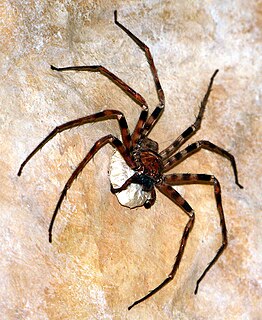
Heteropoda is a genus of spiders in the family Sparassidae, the huntsman spiders. They are mainly distributed in tropical Asia and Australia, while at least one species, H. venatoria, has a cosmopolitan distribution, and H. variegata occurs in the Mediterranean.
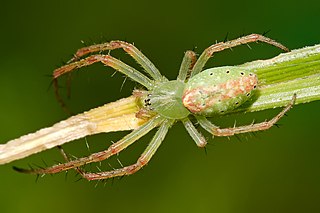
Cyrtophora, the tent-web spiders, is a genus of orb-weaver spiders first described by Eugène Simon in 1895. Although they are in the "orb weaver" family, they do not build orb webs. Their tent-like, highly complex non-sticky web is sometimes considered a precursor of the simplified orb web. These webs are aligned horizontally, with a network of supporting threads above them. These spiders often live in colonies. Females have a body length of mostly about 10 millimetres (0.39 in) long. Some members, including Cyrtophora cicatrosa, exhibit the ability to change colour rapidly.

Theridion is a genus of tangle-web spiders with almost 600 described species around the world. Notable species are the Hawaiian happy face spider (T. grallator), named for the iconic symbol on its abdomen, and T. nigroannulatum, one of few spider species that lives in social groups, attacking prey en masse to overwhelm them as a team.

Clubiona is a genus of sac spiders that was first described by Pierre André Latreille in 1804.
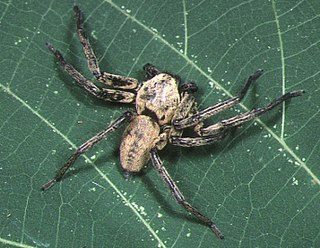
Thelcticopis is a genus of huntsman spiders that occurs almost exclusively in the area India to Japan to New Guinea and Fiji. However, one species occurs in Costa Rica, and another in Congo basin, although the latter species is probably misplaced in this genus.

Tetragnatha is a genus of long-jawed orb-weavers found all over the world. It was first described by Pierre André Latreille in 1804, and it contains hundreds of species. Most occur in the tropics and subtropics, and many can run over water. They are commonly called stretch spiders in reference to their elongated body form and their ability to hide on blades of grass or similar elongated substrates by stretching their front legs forward and the others behind them. The name Tetragnatha is derived from Greek, tetra- a numerical prefix referring to four and gnatha meaning "jaw". Evolution to cursorial behavior occurred long ago in a few different species, the most studied being those found on the Hawaiian islands. One of the biggest and most common species is T. extensa, which has a holarctic distribution. It can be found near lakes, river banks or swamps. Large numbers of individuals can often be found in reeds, tall grass, and around minor trees and shrubs.

Cyrtarachne is a genus of orb-weaver spiders first described by Tamerlan Thorell in 1868.

Oxyopes is a genus of lynx spiders found worldwide. It includes arounds 300 species and is classified under the lynx spider family Oxyopidae. Like other lynx spiders, they are easily recognizable by the six larger eyes arranged hexagonally on top of the head (prosoma), with the remaining smaller two eyes in front. They are also characterized by long spine-like bristles (setae) on their legs. They are ambush predators, actively hunting prey by sight. Though they produce and use silk, they do not build webs to capture prey.
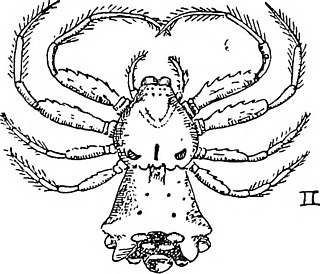
Phrynarachne is a genus of crab spiders first described by Tamerlan Thorell in 1869.

Poltys is a genus of orb-weaver spiders first described by C. L. Koch in 1843. Many species are cryptic and are known to masquerade as leaves and twigs during the day, and build an orb web at night to capture prey. The shape of the abdomen which often gives the impression of a rough and broken branch can vary among individuals within a species. The web is eaten up before dawn and reconstructed after dusk.

Anepsion is a genus of orb-weaver spiders first described by Embrik Strand in 1929.

Hamataliwa is a genus of lynx spiders that was first described by Eugen von Keyserling in 1887.
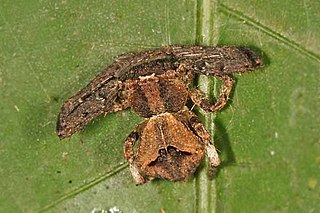
Angaeus is a genus of Asian crab spiders first described by Tamerlan Thorell in 1881. It is considered a senior synonym of Paraborboropactus.
















